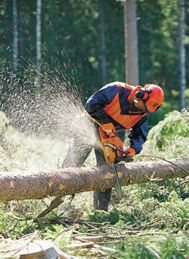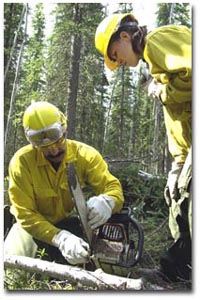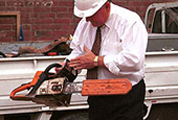

Major hazards associated with chainsaws are:

Anyone using a chainsaw needs to have received adequate training and be competent in the use of the chainsaw. Read the manufacturer’s manual carefully.
Some dangerous operations, such as felling trees on steep slopes or unstable ground, should only be undertaken by professionals.
Some dangerous operations, such as felling trees on steep slopes or unstable ground, should only be undertaken by professionals.

Suitable personal protective equipment (PPE) should always be worn - no matter how small the job.Wear the following PPE when operating a chainsaw:
Remember: No PPE can ensure 100% protection against cutting by a chainsaw.
Kickback is the sudden, unexpected upward and backward movement of the chain and guide bar. This can occur when the end part of the guide bar nose strikes a solid object. Kickback may result in serious or fatal injury.
Proper maintenance will reduce the effect of kickback. To reduce the risk of kickback follow safe operating techniques:
Proper maintenance will reduce the effect of kickback. To reduce the risk of kickback follow safe operating techniques:

■
Physical contact with the blade, which may result in severe injury to different parts of the body
■
Exhaust fumes which contain carbon monoxide
■
High noise levels
■
Vibration diseases
■
Always check equipment before use
■
Never use chainsaws above shoulder height
■
Ensure someone is within calling distance
■
Never cut material other than wood with chainsaws
■
Match the size of the saw and bar with the material being cut
■
Match the size of the saw and bar with the material being cut
■
Do not operate a chainsaw in wet or windy conditions or in poor light
■
Always wear suitable personal protective equipment
■
Footwear: Boots with steel toe caps. Lace-up boots must be securely tied
■
Leg protection: safety trousers or chaps
■
Safety helmet
■
Hearing protection: earmuffs rated Grade 4
■
Eye protection: goggles or helmet visor
Hold the chainsaw firmly with both hands. Grip the handles with the fingers and thumb. Never use the saw with one hand!
Keep both feet firmly planted in a balanced position.
Position your body to the side of the intended cut in case of kickback.
Maintain engine speed as you cut. Reduce speed when the cut is almost finished.
Regularly check chain tension.
There are three different types of cutting action: down cut, up cut and the boring cut. See A guide to safety with chainsaws (OSH) for detailed information.
Watch the guide bar nose and do not let it come in contact with any object.
Hold the saw firmly with both hands. Keep the left thumb under the front handle.
Do not over reach or cut above shoulder height.
Ensure the safety devices such as the chain brake are working
Keep both feet firmly planted in a balanced position.
Position your body to the side of the intended cut in case of kickback.
Maintain engine speed as you cut. Reduce speed when the cut is almost finished.
Regularly check chain tension.
There are three different types of cutting action: down cut, up cut and the boring cut. See A guide to safety with chainsaws (OSH) for detailed information.
Watch the guide bar nose and do not let it come in contact with any object.
Hold the saw firmly with both hands. Keep the left thumb under the front handle.
Do not over reach or cut above shoulder height.
Ensure the safety devices such as the chain brake are working
Facts and Figures about Chainsaw InjuriesAccording to the U.S. Consumer Products Safety Commission there were over 28,500 chain saw injuries in 1999. More than 36% were injuries to the legs and knees.
The average chainsaw injury requires 110 stitches and the average medical cost was $ 5,600.00 in 1989. Data according to The Davis Garvin Agency, an insurance underwriter specializing in loggers insurance. In year 2000 corresponding costs can be estimated to be over $12,000.00.
Medical costs for chainsaw injuries based on these facts amount to about 350 million dollars per year.
The average chainsaw injury requires 110 stitches and the average medical cost was $ 5,600.00 in 1989. Data according to The Davis Garvin Agency, an insurance underwriter specializing in loggers insurance. In year 2000 corresponding costs can be estimated to be over $12,000.00.
Medical costs for chainsaw injuries based on these facts amount to about 350 million dollars per year.
Workman's compensation costs, based on the assumption that four weeks recovery is required, can be estimated at 125 million dollars annually.
Loss of production as well as loss of quality of life for the injured can not be adequately quantified, but may in fact represent the single largest cost.
There are 69,000 professional loggers in the U.S.. The cost of equipping all of them with one pair of chainsaw chaps at approximately $75.00 each would result in a total annual expense of five million dollars.
There are few situations where safety has a more immediate payback than in the logging industry.
Loss of production as well as loss of quality of life for the injured can not be adequately quantified, but may in fact represent the single largest cost.
There are 69,000 professional loggers in the U.S.. The cost of equipping all of them with one pair of chainsaw chaps at approximately $75.00 each would result in a total annual expense of five million dollars.
There are few situations where safety has a more immediate payback than in the logging industry.


